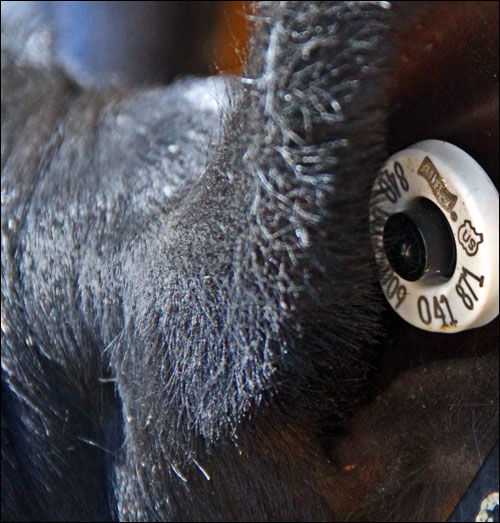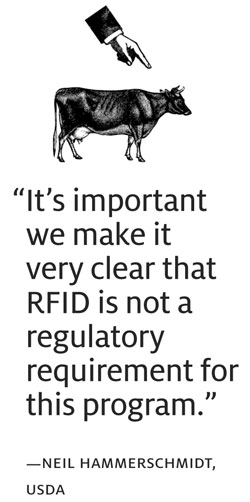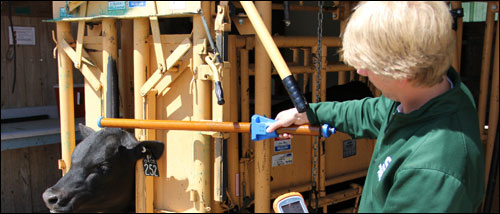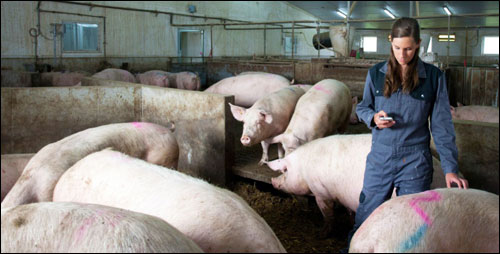The Montreal Canadiens lost to the Tampa Bay Lightning in the second round of the National Hockey League Stanley Cup playoffs this year, but the players headed off the ice with their heads held high. The team posted 110 points in regular season play, finishing second overall in the Eastern Conference, just behind the New York Rangers.
The Canadiens attribute much of their 2014-15 season success to their enhanced training efforts, which includes the use of Sport Testing’s athlete assessment solution, particularly during summer development and training camp sessions. The solution consists of Sport ID passive ultrahigh-frequency RFID bands to identify athletes via an RFID handheld reader before they perform a particular drill; wireless Sport Gate photoelectric timing gates that use Sport ID data and the company’s Core Capture algorithms to match athletes with the measurement results from specific drills in real time; Sport Hub software for collecting results that can be displayed on any screen or even a leaderboard to motivate players; and Athlete Manager database software, which provides reports on which to base analyses of player performance.
The Canadiens use the solution to test a number of variables relevant to the sport of hockey, says Pierre Allard, the team’s strength and conditioning coach. During a circuit, for example, it will benchmark how quickly a player reacts to lights and colors that indicate whether he should move right or left. “That’s a good test, because you want to see if the players controlling a puck can make good decisions,” he says. “Another test is to measure the capacity to repeat sprints, which is also an important value for hockey players.” The results, he adds, help him determine what aspects of play a team member needs to work on, and develop ways to improve them.
The RFID bands make the whole process convenient, Allard says, because they accurately and quickly match players to results. “Once you set up the system and get used to it, you save a lot of time, because you can start to collect data,” he says. “And with RFID, you are able to go fast.”
Over time, Allard can use the collected data from players running different drill combinations to create standards, such as minimum and maximum values of speed, strength and power. Understanding what constitutes good values for NHL players, for example, can help monitor the progression of young draft players, he says, “to see if they are going in the right direction over time from a physical condition standpoint.”
In addition to the Canadiens and a few other professional hockey and football teams, company founder Jamie Hollins says Sport Testing has relationships with sports organizations including: the Canadian Hockey League, which represents major junior ice-hockey leagues for players 16 to 20 years of age; National Lacrosse League, North America’s professional indoor lacrosse league; Amateur Athletic Union, a U.S.-based organization promoting the development of amateur sports; American Youth Football, an international organization; and Canadian Sports Institute for Olympic and Paralympic training.
Sport Testing also maintains a global database of up-and-comers’ test results that organizations can access to monitor individuals’ performance in sport-specific drills. The information helps them “make proper decisions about who should progress or be dropped for the draft or scholarship,” Hollins says. “Everything is moving into the data world and into more analytics, and RFID lets us gather that data efficiently.”
It’s a New Game
Using RFID to capture real-time performance statistics on male and female athletes is a growing trend, and solution providers are stepping into the sports arena. “New digital technologies and new applications of old digital technologies are being used to quantify everything related to sports, providing a different insight and the option for a lot of analysis,” says Henry Hanson, sports equipment specialist and co-creator of the Sports Technology Podcast. “For training, any extra information gathered—if gathered and interpreted correctly—can only benefit the athlete by providing a more complete picture of what is going on.”
SportRFID, for example, offers a solution that uses passive UHF RFID sticker tags that can be affixed to a snowboarder’s helmet during training or competition. RFID readers placed strategically along a course—such as at points where snowboarders do a 180-degree spin—recognize the RFID stickers and activate multi-angle video cameras. The videos are uploaded to the cloud for review by the athletes, their coaches and others, such as the Canada Snowboard federation.
“Federations want to know who is progressing, at what rate and so on, so they can maneuver their resources to get behind those with the best chance of medaling at various competitions,” says SportRFID CEO George Easton. “We dovetailed nicely with what Canada Snowboard wanted to do.” The solution, Easton adds, can also be used for downhill skiing, bike racing and other sports with a progressive course that provides an opportunity to set up defined video-capture points.
The New York Knicks, Dallas Cowboys and San Antonio Spurs are among the professional organizations using Catapult‘s technology to gain scientific insights into their athletes’ performance, says Boden Westover, the company’s marketing director. Catapult’s ClearSky is an RFID-based active real-time location system (RTLS) that can be deployed in indoor or outdoor sports environments. OptimEye, the company’s original satellite-based system, requires an outdoor or open-roof venue.
“ClearSky uses RFID because of its accuracy and ability to be used in a range of environments, which is important with our clients training in different venues on a regular basis,” Westover says. An athlete’s location is calculated via triangulation using small wireless nodes that are easy to install around the perimeter of a playing area, he explains. Athletes wear a small tracking device under their uniforms that measures and records their physical movements every few seconds, including distance covered, accelerations, velocity and direction changes, as well as heart rate.
The data is accumulated in real time so coaches can view it on a laptop during a practice or game, and saved for post-session analysis in Catapult’s OpenField software. Coaches can gain insights into risk (understanding when an athlete is being overworked and at a greater chance of sustaining a soft-tissue injury); readiness for competition (objectively knowing how physically prepared an athlete is for a game or training); and return to play (when an injured athlete can return to competition), Westover says. The tracking devices will continue to become smaller and more sophisticated, he says, but the real developments ahead “will be in the data and the sport-specific and position-specific algorithms we build into the system, to ensure the information is as relevant and valuable as possible to the teams using it.”
At the University of North Carolina, women’s varsity soccer and several other teams have been using the OptimEye solution. “If you look at where we were before we had this, you were just kind of guessing about whether an athlete was stressed out or had a chance of getting hurt,” says Greg Gatz, UNC’s director of strength and conditioning for Olympic Sports. “It’s not an exact science but at least now we have a reference point.”
Vert uses Bluetooth Low Energy technology to track and analyze jump height, an important factor in basketball and volleyball. Jump height also comes into play in some facets of other sports; in football, for example, a wide receiver may need to jump to catch a pass. A Vert device is worn on an athlete’s waist or integrated into an article of clothing, such as the company’s active waistband. A proprietary algorithm measures the jump, and Vert transmits the data to any smartphone or device that supports BLE.
Every player on the U.S. Women’s National Volleyball Team wears a Vert during training, says Jamie Morrison, assistant coach. The system helps coaches with talent preservation. It records information such as how many jumps a player makes and how many times a player hits her maximum jump height. The data could reveal that a player is risking injury by taking too many jumps, or getting tired and consistently declining in jump height. Twelve players from this group will be picked for the U.S. Women’s Olympics team.
“There are a lot of overuse injuries in our sport—there is a lot of pounding,” Morrison says. “We’re more interested in longevity, and up until now there has been no tool to manage the workload and make sure we are working athletes the right amount.”
Active RFID technology using Wi-Fi networks may be part of the future for Vert, says founder Martin Matak, especially given the interest in the solution by national and professional sports teams. The company has conducted lab experiments with the technology, and Matak thinks it could bring extra value because it is “simpler to triangulate where people are in a field of space, so you can create different elements” to accompany the vertical data. “In a football scenario,” he says, “you would want to measure verticals, speed and location, and technologies like RFID could come into play to be part of that platform solution.”
Broadcasting Performance Data
Players’ stats have long been part of the sporting game, so it’s no surprise that the media and fans are interested in RFID-generated performance stats. Last year, during a National Collegiate Athletic Association (NCAA) live event, members of the University of Florida women’s volleyball team wore Vert devices, and their jump height data was displayed in real time on a Jumbotron. An ESPN broadcast of a women’s volleyball game between the University of Florida and the University of South Carolina also featured Vert jump stats.
“Being the first wearable technology in an NCAA event, we are going down that road to create new experiences in sports analytics and entertainment,” Matak says. Vert is building an application to engage socially with fans at stadiums and at home on smartphones. “Everyone wants instant information that is important to them,” he says. “We are building a platform that has the consumer in charge of their own experience.”
SportRFID has explored broadcast options to enhance the fan experience, but Easton notes it’s not the company’s current focus. “All I can tell you is that the interest is quite high, but the path to execution is riddled with many hoops to jump through,” he says, citing contractual obligations and licensing agreements.
Catapult’s Westover says there are a few offshoots from its core business “that largely center around the media and working with broadcast partners, but because of the proprietary nature of the data, it is not as straightforward as a lot of people believe. We’ve had some successful examples in Australian football, and it’s something we’re keeping an eye on going forward.”
Meanwhile, the National Football League, which adopted Zebra Technologies’ MotionWorks Sports Solution to monitor players, installed the ultrawide-band RTLS at 17 stadiums during the 2014-15 season and plans to RFID-enable the remaining 14 stadiums for the 2015-16 season (see Zebra’s Next-Gen Technology Powers Next-Gen Stats). More than 100 million fans, including viewers of CBS Sports’ Thursday Night Football TV, saw what the NFL and Zebra call “next-generation statistics.”
The NFL is gearing up to build what Eric Petrosinelli, Zebra’s general manager of sports, calls an ecosystem for digital fan offerings. In April, the NFL signed a multiyear agreement with Sportradar US to be its exclusive distributor of official real-time scores, player statistics and play-by-play data, as well as the NFL’s proprietary next-gen stats.
“The MotionWorks system’s reliability was nearly 100 percent in the past year—no tag failures,” Petrosinelli says. “It smoothly passed the information to broadcast partners. On the commercial side, they are just at the start of rolling out next-gen stats, and we’ll start seeing where they are setting up different channels through which the data is monetized.” There remain protocols to work out regarding data distribution for the clubs that own the NFL as an entity, he says. Some, for example, might not want to share all their players’ data with external parties or other clubs.
Zebra Sports is rolling out a complementary product with similar functionality to MotionWorks to track football players and their performance during practice. So far, the Detroit Lions, New Orleans Saints and San Francisco 49ers have adopted it. The solution enables coaches to optimize training schedules for top game-day output; if, for example, a player worked really hard at drills, they could scale back his practice the next day. Coaches can also use player positioning and timing stats to better understand how plays were run, so they can address incomplete passes and other errors during practice. “Just as Zebra does for its enterprise asset-intelligence solutions, we’ll provide operational visibility to managers and coaches to make better, faster and smarter decisions,” Petrosinelli says.
Those coaching and managing sports today think real-time performance solutions are becoming an increasingly important asset, though they caution against losing the human connection when it comes to assessing and preparing athletes. These are “tools to use within the system, not something to base a whole program on,” says UNC’s Gatz.
“The human factor is still the best for us right now to evaluate and determine the progression of the players’ conditioning,” concurs the Canadiens’ Allard. But, he adds, “We are in a data era” and RFID-enhanced sports solutions that help gather that data are useful in supporting those decisions.”
Radio Alerts Could Reduce Brain Injuries
Concussions are an unfortunate fact of life for many athletes, both professional and amateur. Adults and kids suffer head traumas playing football, soccer, hockey and other sports. Wrestlers, boxers and cheerleaders are also susceptible to head injuries. Often, a player who sustains a concussion stays in the game, although repeated concussions can lead to permanent brain damage.
Wireless sensor technologies can’t prevent or diagnose concussions, but they can measure head accelerations (the force and rotation with which the brain hits the skull). This real-time information can alert coaches that a player should be examined by a doctor and, perhaps, pulled from the game.
Jolt’s wearable sensor and smartphone application, for example, lets parents and coaches track and evaluate the impact to a child’s head. The Jolt Sensor, which can be attached to headbands, helmets and other headgear, measures and records head accelerations, and streams the data and corresponding alerts to smartphones using Bluetooth Low Energy (BLE) technology. Following a successful Kickstarter campaign and certification from the U.S. Federal Communications Commission, Jolt began shipping products in July, says founder and CEO Ben Harvatine.
Riddell, which manufactures professional football helmets and other protective equipment, offers Riddell IQ, a smart football platform that includes the Sideline Response System and InSite Impact Response System. InSite features a sensor pad that is positioned in helmet liners to measure impact severity and BLE technology to send alerts to handheld devices, by player name and number, when an impact or sequence of impacts exceeds a predetermined threshold. Riddell says members of the National Collegiate Athletic Association are using the SRS solution largely for research, while close to 500 high-school and youth programs have adopted InSite.
“Concussions are more complicated than accelerations,” says Henry Hanson, co-creator of the Sports Technology Podcast. “But any extra information about what the head experienced could help doctors better understand the severity of the incident.”








